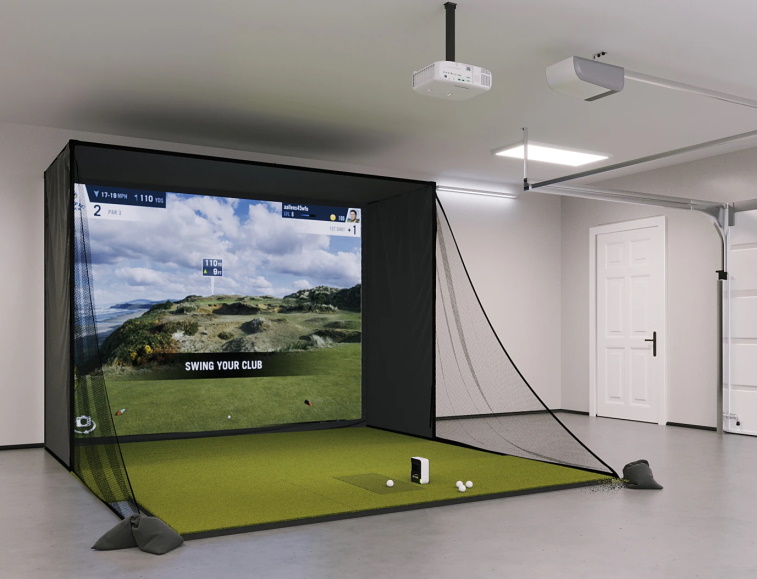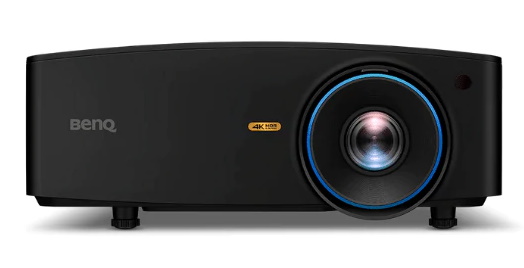Golfstead is reader-supported. When you buy through links on the site, we may earn an affiliate commission at no extra cost to you. Our affiliations include, but are not limited to, the eBay Partner Network and Amazon Associates.

One of the biggest obstacles to owning a golf simulator is having the space for it. It’s a make-or-break requirement: if you don’t have the space, you can’t use it.
Every golf simulator will consist of a launch monitor or some other kind of tracking system. Beyond that, a hitting net, hitting mat, enclosure system or projector may be involved depending on the setup you want to go for.
All of these component parts need to be able to fit in your space.
Generally speaking, when figuring out if a space is big enough for a particular simulator, you need to consider the following four factors:
In this guide, we’ll go over each of these factors so you have a good idea of how much space you’ll need for a golf simulator. We’ll also provide additional tips that will help you achieve your ideal setup.
Remember that there are many golf simulator systems out there that can accommodate a range of space sizes, so just because one setup won’t fit in your space doesn’t mean another won’t.
What To Consider
1. Ceiling Height

Ceiling height tends to be one of the biggest issues for most people looking to install a golf simulator.
There are several reasons why it’s so essential. It determines:
- whether or not you can swing your clubs freely
- whether or not your enclosure or net can fit
- whether or not ceiling-mounted launch monitors can operate properly
As a general rule, 8 feet is the bare minimum ceiling height requirement for a golf simulator. 8.5 feet is better, but 9 feet or more is ideal.
Unfortunately, many older homes in the USA and other countries, particularly those built before the 21st century, have 8-foot standard ceiling heights. It’s only recently that homes have begun to be built with 9-foot ceilings.
Swinging Your Clubs Freely

The problem with an 8-foot ceiling is that most people will have to shorten their backswing or avoid using longer clubs like woods and drivers in order to not hit the ceiling during the swing.
Even then, the anxiety and trepidation about possibly hitting the ceiling during the swing will likely affect the quality of your ballstriking.
Of course, it will depend heavily on your height and the actual length of your clubs. This is why we recommend taking out your longest club (usually driver) and making a full backswing to ensure you have enough clearance, preferably while you’re standing on a hitting mat which will elevate you slightly off the ground.
Fitting The Enclosure Or Net
Practically all enclosures or hitting nets will require a minimum of 8 feet of ceiling height. Many will require at least 8.5 feet, and some even 9 feet.
Here are some examples of high-quality enclosure systems and their heights:
- SwingBay Enclosure by Rain or Shine Golf: 8 ft high
- SIG10 Enclosure by The Indoor Golf Shop: 8’4″ high
- Carl’s Place C-Series DIY Enclosure: 8 ft high (other sizes available)
- PerfectBay Enclosure by Top Shelf Golf: 8 ft high
- HomeCourse ProScreen 180 Enclosure: 8 ft high
Despite these minimum requirements, you want to try to have a cushion of at least half a foot between the top of the enclosure and the ceiling so that the ball doesn’t hit the ceiling if it touches the top blackout wall.
Some examples of high-quality hitting nets and their heights are:
- SIGPRO Golf Hitting Net: 7’7″ high
- The Net Return Home Series V2 Net: 7 ft high
- GoSports ELITE Hitting Net: 7.5 ft high
Nets generally require less height than enclosures, but you still want to have a little bit of space between the top of the net and the ceiling for safety and comfort.
Using A Ceiling-Mounted Launch Monitor
Launch monitors that are meant to be mounted in a fixed position on the ceiling typically require a minimum vertical distance to be able to measure data properly. See the table below for examples:
| Launch Monitor | Minimum Height |
|---|---|
| Uneekor QED | 9 feet |
| Uneekor EYE XO or EYE XO2 | 9 feet |
| Foresight Sports GCHawk | 10 feet |
As you can see, if you plan to use these kinds of launch monitors, you shouldn’t bother with any ceiling height less than 9 feet unless you want to risk significant performance issues.
If you do have a ceiling height that is too low and there is no other space where you could house your golf simulator, there are many ways you might be able to raise the ceiling depending on the construction of the space itself.
Raising the ceiling height can be very difficult if not impossible to DIY, so if you’re interested in going this route, we recommend the services of a professional.
2. Enclosure/Net Size
Your golf simulator enclosure or hitting net, as well as the entire hitting bay itself, obviously needs to be able to fit in your space.
One part of this is the ceiling height which we discussed in the above section. The other crucial factors are the width and the depth of the space.
Width
The minimum width requirement for an enclosure or hitting net is usually about 10 feet, although there are exceptions such as the compact SIG8 enclosure and 8’x8′ Carl’s Place enclosure.
We recommend a buffer of at least half a foot of space on either side of the enclosure. Other than that, room width is one of the easiest things to deal with.
Depth
The minimum depth requirement of a golf simulator is, on average, about 12 feet, but it can vary from 10 feet to as much as 20 feet depending on the size of the hitting bay, launch monitor requirements, and projector position.
In addition to these things, most people will want to have things in front of the simulator bay such as a seating area, in which case even more depth will be needed.
3. Projector Mounting Location
If you’re just using a hitting net with your golf simulator setup, you can safely skip this section.
If you plan to use an impact screen with a projector, this may influence how much depth you need for your space. There are a few things you need to consider on this front.
Firstly, if you’re using a short throw projector, it likely won’t have any impact on your space requirements because it can usually be placed within 10 feet of the screen and still produce a full-size image. This applies whether the projector is mounted on the floor or the ceiling.
On the other hand, if you’re using a standard throw projector (throw ratio of 1:1 or greater), the projector will need to be farther away from the screen. Depending on the space requirements of the launch monitor and where your hitting mat is, this could mean the projector will be behind you.
Let’s take a hypothetical example. Suppose your impact screen is 10 feet wide (which is pretty standard) and you’re using one of our top recommended standard throw projectors for golf simulators, the Panasonic PT-VZ580U.
Because this projector has a throw ratio of 1.09-1.77:1, it will need to be placed anywhere from 10.9 ft to 17.7 ft from the screen. This may require more depth than what the enclosure and launch monitor call for.
The bottom line is this: you need to take note of the throw ratio of your projector and where the projector needs to be positioned relative to the impact screen. Make sure that the depth of your space can accommodate this.
In fact, short throw projectors are usually recommended for golf simulators (if the budget allows) because they minimize or eliminate the chances of needing to put the projector excessively far away from the screen where they can cause shadows. One of our top recommended short throw projectors is the Optoma GT1080HDR.
4. Launch Monitor Requirements
The last factor that affects how much space you need for a golf simulator (but certainly not the least important) is the launch monitor.
In the absence of a launch monitor, you would simply make sure you have enough space in front of you and behind you to swing your longest club without impedance.
But launch monitors, particularly radar-based ones like the Mevo Plus, Garmin Approach R10 and Full Swing KIT, require a fair amount of space behind the golfer as well as between the screen and the ball to work properly.
Typically, radar launch monitors need a minimum of 8 feet of ball flight (between the hitting mat and screen) and must sit 7-9 feet behind the golfer. If you add these two numbers up, it means you’d need a room depth of at least 15-17 feet, and the more the better.
However, camera-based launch monitors like the SkyTrak, GC3, GCQuad, and Uneekor QED don’t have such demanding space requirements. They sit directly in front of (or above) the golfer and only need a couple feet of ball flight for optimal performance.
This is the reason why we recommend camera-based launch monitors for indoor use. In any event, it’s essential that you look at the space requirements of whatever launch monitor you’re interested in and make sure you can accommodate them.
Conclusion
Generally speaking, you should strive for a space with 9 feet of ceiling height, 12 feet of width, and 16-18 feet of depth. This should work for most setups.
The reality is that the space a golf simulator is housed in is just as important as the quality of the simulator itself.
And apart from cost, it’s probably the biggest obstacle to ownership for people trying to fit a simulator into an existing home or other building.
Having said that, with some planning and research of the different simulator options available to you, you will almost certainly be able to find a setup that works for you.
Building A Space Around A Simulator
If you think the the only option is to try to fit a golf simulator into an existing space, think again. There is an alternative.
With services like InHome Golf, a team of experts can help you design and install a unique & personalized space for a golf simulator that falls within your budget.
This can involve custom sizing, curating the best simulator components based on your needs, and designing a custom entertainment center just for you that is suitable for not just golf, but also gaming and movies.
Ready to start putting together your golf simulator? Shop at our top recommended indoor golf stores below:
Thanks for reading this guide. Tell us about your golf simulator situation in the comments below.






